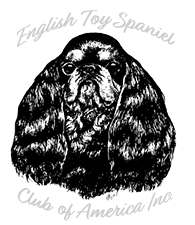The English Toy Spaniel
For Centuries A Loving Companion
By Amanda Watlington
Reprinted from Top Notch Toys
August 1991
The English Toy is a very old breed with a distinguished ancestry. The crowned heads of Europe and England have long enjoyed and cherished the company of small spaniels, ancestors to the dogs of today.
The royal Stuarts, early fanciers – most notably King Charles I – gave their name to the breed. In England today all four varieties of the breed are known as King Charles Spaniels. Here in the United States, King Charles is applied only to the black and tan variety. The all red dog is called a Ruby. The red and white dogs, the Blenheims, are named for Blenheim Castle, the ancestral Churchill home, where this variety was extensively bred. The tri-color dogs are called Prince Charles, after yet another royal fancier.
Charles II was such an ardent fancier that Samuel Pepys in 1660 chided him for playing with his dogs and not attending to business. Even today, the dogs are such compelling little companions that fanciers are often rebuked by friends and relatives, not of such august reputation as Pepys, for lavishing time on their dogs. It was Charles II’s sister Henrietta Maria who brought to England from the French Court the little black and tan Pyrame spaniel with the fused feet still seen in the breed today.
By Charles II’s era, the breed was already centuries old, for its origins trace further back to the Crusades. As early as the 13th Century, a Knight Fitz-Ralph, returning from the Crusades, brought with him from Italy a strain of small, beautiful spaniels. An effigy in his parish Church at Pebmarsh, Essex, shows an early specimen of the breed. The spaniel is curled at the feet of a knight standing in full armor. The dog is in a most characteristic pose.
English Toy Spaniels today will go to great lengths to wrap themselves at their owner’s ankles in a pose reminiscent of the effigy. In our hurried late twentieth-century life this can be a bit cumbersome. The dogs show no fear of being treaded upon, for they are totally trusting of their owners. They are merely trying to get as close to their masters as possible. If the master is seated, the dog will instantly seek a lap for even closer and more satisfying contact.
